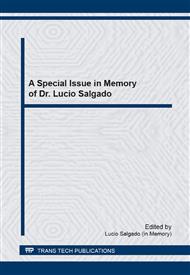[1]
W.A. RUTALA: Am. Journal of Infectology Control Vol. 17 (1) (1999), p.24-A.
Google Scholar
[2]
K.C.N. CARVALHO: A Esterilização. Doutorado (Tese). Campo Grande, 2002. Universidade Federal do Mato Grosso do Sul (UFMS). (MS).
DOI: 10.5212/terraplural.v.16.2219806.023
Google Scholar
[3]
B.D. RATNER, A.S. HOFFMAN, F.J. SCHOEN and J.E. LEMONS: An Introduction to Materials in Medicine. (Academic Press 1ª Ed. San Diego, 1996).
Google Scholar
[4]
S.N. SANDERS; Esterilização de termossensíveis. (2002). Disponível em http: /www. cenat. com. br/conteudo_informes. html. Acesso em 19 de junho de (2011).
Google Scholar
[5]
J.C. AZEVEDO, A.S. CRUZ and T.J.A. PINTO: Brazilian Journal of Pharmaceutical Sciences. Vol. 42 (2) (2006).
Google Scholar
[6]
J. PARK, R.S. LAKES: Biomaterials: an Introduction. (Springer 3th Edition New York, 2007).
Google Scholar
[7]
G. BIAGINI, R.A.A. MUZZERELLI, R.E. GIARDINO and C. CASTALDINI, Biological Material for wound healing. In: BRINE, I.; CHARLES, J. Advanced in chitin and chitosan. Elsevier Science Publishers, London (1992).
DOI: 10.1007/978-94-011-5942-5_3
Google Scholar
[8]
P.R.M. DALLAN: Síntese e caracterização de membranas de quitosana para aplicação na regeneração da Pele. Doutorado (Tese). Campinas, 2005. Universidade Estadual de Campinas (UNICAMP). (SP).
DOI: 10.47749/t/unicamp.2005.359143
Google Scholar
[9]
O.B.G. ASSIS, V.L. SILVA: Polímeros: Ciência e Tecnologia Vol. 13(4) (2003), p.223.
Google Scholar
[10]
I.Y. KIMURA, V.T. FÁVERE, A.O. MARTINS, V.P. SPINELLI and A. JOSUÉ: Maringá Vol. 23 (6) (2001), p.1313.
Google Scholar
[11]
M.C. TORRES, Produção e caracterização de microesferas de quitosana natural e modificada quimicamente e o seu uso na adsorção das proteínas BSA e losozima. Doutorado (Tese). Campinas, 2006. Universidade Estadual de Campinas (UNICAMP/FEQ). (SP).
DOI: 10.47749/t/unicamp.2006.375876
Google Scholar
[12]
Z.L. KNAULL, S.M. HUDSON and A.M.K. CREBER: Journal of Applied Polymer Science -Part B: Polymer. Phisical Vol. 37 (11) (1999), p.1079.
Google Scholar
[13]
H.H.K. XU and SIMON C.G. Jr.: Biomaterials Vol. 26 (2005), p.1337.
Google Scholar
[14]
T. URAGAMI and S. TOKURA, Materials Science of Chitin and Chitosan: (Kodansha Ltd. Japan, 2006).
Google Scholar
[15]
Y. KOYAMA, A. TANIGUCHI, C.P. HUANG and D.W. BLAKENSHIP: Journal of Applied Polymer Science Vol. 31 (1986), p. (1951).
Google Scholar
[16]
M.M. BEPPU, R.S. VIEIRA, C.G. AIMOLI and C.C. SANTANA: Journal of Membrane Science Vol. 301 (2007), p.126.
Google Scholar
[17]
L. LIM, E. KHOR, O. KOO: γ- Irradiation of Chitosan. (John Wiley & Sons, Inc. 1998).
Google Scholar
[18]
S.R. VIEIRA: Remoção e recuperação de íons Hg (II) utilizando quitosana natural e reticulada. Mestrado (Dissertação). Campinas, 2004. Universidade Estadual de Campinas (UNICAMP/FEQ). (SP).
DOI: 10.47749/t/unicamp.2004.319158
Google Scholar
[19]
S. NAKATSUKA and A.L. ANDRADY: Journal of Applied Polymer Science Vol. 44 p. (1992), p.17.
Google Scholar
[20]
G.A.F. ROBERTS and K.E.; TAYLOR: Makromolecules Chemical Vol. 190 (1989), p.951.
Google Scholar


